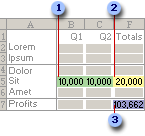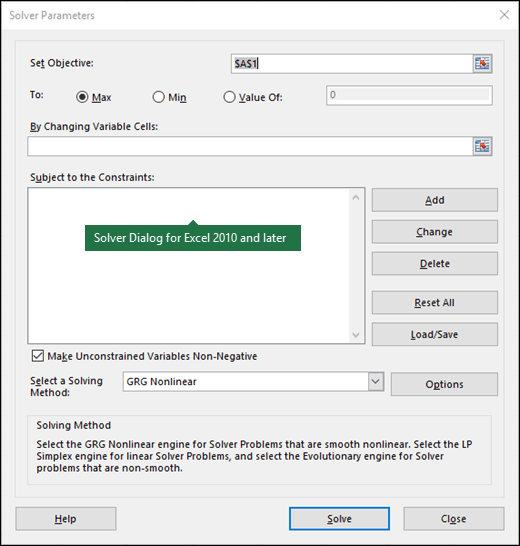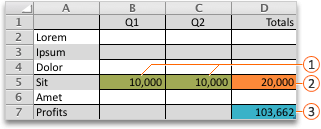How To Add A Constraint To The Current Solver Model
Solver is a Microsoft Excel add-in program you can use for what-if assay. Apply Solver to find an optimal (maximum or minimum) value for a formula in one cell — called the objective cell — subject to constraints, or limits, on the values of other formula cells on a worksheet. Solver works with a group of cells, called determination variables or simply variable cells that are used in computing the formulas in the objective and constraint cells. Solver adjusts the values in the decision variable cells to satisfy the limits on constraint cells and produce the issue you want for the objective jail cell.
Put simply, you can use Solver to determine the maximum or minimum value of one cell past changing other cells. For example, you can change the amount of your projected advert budget and come across the outcome on your projected profit amount.
Notation:Versions of Solver prior to Excel 2007 referred to the objective cell as the "target cell," and the decision variable cells as "changing cells" or "adjustable cells". Many improvements were made to the Solver add-in for Excel 2010, so if yous're using Excel 2007 your experience volition be slightly unlike.
In the post-obit instance, the level of advertising in each quarter affects the number of units sold, indirectly determining the amount of sales revenue, the associated expenses, and the profit. Solver can change the quarterly budgets for advertising (decision variable cells B5:C5), up to a total budget constraint of $20,000 (jail cell F5), until the total profit (objective cell F7) reaches the maximum possible amount. The values in the variable cells are used to calculate the profit for each quarter, and so they are related to the formula objective prison cell F7, =SUM (Q1 Profit:Q2 Turn a profit).

one. Variable cells
2. Constrained prison cell
3. Objective prison cell
After Solver runs, the new values are as follows.

-
On the Data tab, in the Analysis grouping, click Solver.

Note:If the Solver command or the Analysis group is not available, you need to activate the Solver add together-in. See: How to activate the Solver add-in.

-
In the Set up Objective box, enter a cell reference or name for the objective cell. The objective cell must contain a formula.
-
Exercise one of the following:
-
If you lot want the value of the objective cell to exist equally large every bit possible, click Max.
-
If you lot desire the value of the objective cell to be as small as possible, click Min.
-
If you want the objective prison cell to exist a certain value, click Value of, and so type the value in the box.
-
In the By Changing Variable Cells box, enter a name or reference for each decision variable cell range. Divide the non-adjacent references with commas. The variable cells must exist related directly or indirectly to the objective cell. Y'all tin can specify up to 200 variable cells.
-
-
In the Field of study to the Constraints box, enter any constraints that you lot want to utilise by doing the following:
-
In the Solver Parameters dialog box, click Add.
-
In the Prison cell Reference box, enter the cell reference or name of the cell range for which you want to constrain the value.
-
Click the relationship ( <=, =, >=, int, bin, or dif ) that you want between the referenced jail cell and the constraint.If y'all click int, integer appears in the Constraint box. If you click bin, binary appears in the Constraint box. If yous click dif, alldifferent appears in the Constraint box.
-
If you choose <=, =, or >= for the human relationship in the Constraint box, blazon a number, a cell reference or name, or a formula.
-
Do one of the post-obit:
-
To accept the constraint and add another, click Add.
-
To accept the constraint and render to the Solver Parameters dialog box, click OK.
Note Y'all tin employ the int, bin, and dif relationships just in constraints on decision variable cells.Y'all tin can change or delete an existing constraint by doing the following:
-
-
In the Solver Parameters dialog box, click the constraint that you desire to alter or delete.
-
Click Change and so brand your changes, or click Delete.
-
-
Click Solve and do i of the following:
-
To keep the solution values on the worksheet, in the Solver Results dialog box, click Go along Solver Solution.
-
To restore the original values before you clicked Solve, click Restore Original Values.
-
You tin interrupt the solution process past pressing Esc. Excel recalculates the worksheet with the concluding values that are constitute for the conclusion variable cells.
-
To create a written report that is based on your solution after Solver finds a solution, y'all can click a written report type in the Reports box and and then click OK. The report is created on a new worksheet in your workbook. If Solver doesn't notice a solution, only certain reports or no reports are available.
-
To save your determination variable cell values equally a scenario that you can display after, click Relieve Scenario in the Solver Results dialog box, then type a name for the scenario in the Scenario Name box.
-
-
Afterwards y'all define a problem, click Options in the Solver Parameters dialog box.
-
In the Options dialog box, select the Show Iteration Results check box to run across the values of each trial solution, and so click OK.
-
In the Solver Parameters dialog box, click Solve.
-
In the Bear witness Trial Solution dialog box, practice one of the post-obit:
-
To stop the solution procedure and brandish the Solver Results dialog box, click Stop.
-
To continue the solution process and display the next trial solution, click Go on.
-
-
In the Solver Parameters dialog box, click Options.
-
Choose or enter values for any of the options on the All Methods, GRG Nonlinear, and Evolutionary tabs in the dialog box.
-
In the Solver Parameters dialog box, click Load/Save.
-
Enter a prison cell range for the model area, and click either Save or Load.
When you salvage a model, enter the reference for the start prison cell of a vertical range of empty cells in which you want to identify the problem model. When you load a model, enter the reference for the entire range of cells that contains the problem model.
Tip:Yous tin can salve the terminal selections in the Solver Parameters dialog box with a worksheet by saving the workbook. Each worksheet in a workbook may accept its own Solver selections, and all of them are saved. You can as well define more than 1 problem for a worksheet by clicking Load/Save to salve issues individually.
You tin can cull any of the following 3 algorithms or solving methods in the Solver Parameters dialog box:
-
Generalized Reduced Gradient (GRG) Nonlinear Use for problems that are smooth nonlinear.
-
LP Simplex Use for problems that are linear.
-
Evolutionary Employ for problems that are not-smooth.
Important:You should enable the Solver add-in first. For more information, see Load the Solver add-in.
In the post-obit example, the level of advertizing in each quarter affects the number of units sold, indirectly determining the amount of sales acquirement, the associated expenses, and the turn a profit. Solver tin change the quarterly budgets for advertising (decision variable cells B5:C5), up to a full upkeep constraint of $20,000 (cell D5), until the full profit (objective jail cell D7) reaches the maximum possible amount. The values in the variable cells are used to summate the turn a profit for each quarter, so they are related to the formula objective jail cell D7, =SUM(Q1 Turn a profit:Q2 Profit).

 Variable cells
Variable cells
 Constrained cell
Constrained cell
 Objective cell
Objective cell
Afterward Solver runs, the new values are as follows.

-
In Excel 2016 for Mac: Click Data > Solver.

In Excel for Mac 2011: Click the Data tab, under Analysis, click Solver.

-
In Gear up Objective, enter a cell reference or name for the objective cell.
Note:The objective cell must contain a formula.
-
Do ane of the post-obit:
To
Practise this
Brand the value of the objective prison cell as large as possible
Click Max.
Brand the value of the objective jail cell as pocket-sized as possible
Click Min.
Fix the objective cell to a certain value
Click Value Of, and then type the value in the box.
-
In the By Changing Variable Cells box, enter a name or reference for each decision variable prison cell range. Split up the nonadjacent references with commas.
The variable cells must exist related direct or indirectly to the objective cell. Yous tin specify up to 200 variable cells.
-
In the Field of study to the Constraints box, add any constraints that yous want to apply.
To add a constraint, follow these steps:
-
In the Solver Parameters dialog box, click Add.
-
In the Jail cell Reference box, enter the cell reference or name of the cell range for which you want to constrain the value.
-
On the <= human relationship popular-upwards carte du jour, select the relationship that you want between the referenced cell and the constraint.If y'all choose <=, =, or >=, in the Constraint box, type a number, a jail cell reference or proper name, or a formula.
Note:You can only apply the int, bin, and dif relationships in constraints on determination variable cells.
-
Practise one of the following:
To
Exercise this
Accept the constraint and add some other
Click Add.
Accept the constraint and return to the Solver Parameters dialog box
Click OK.
-
-
Click Solve, and and so do one of the following:
To
Practise this
Keep the solution values on the canvass
Click Continue Solver Solution in the Solver Results dialog box.
Restore the original data
Click Restore Original Values.
Notes:
-
To interrupt the solution process, press ESC . Excel recalculates the sheet with the last values that are establish for the adjustable cells.
-
To create a report that is based on your solution after Solver finds a solution, y'all can click a report blazon in the Reports box and so click OK. The written report is created on a new sheet in your workbook. If Solver doesn't find a solution, the choice to create a report is unavailable.
-
To save your adjusting cell values equally a scenario that you can display subsequently, click Save Scenario in the Solver Results dialog box, and then type a proper name for the scenario in the Scenario Proper name box.
-
In Excel 2016 for Mac: Click Data > Solver.

In Excel for Mac 2011: Click the Data tab, under Assay, click Solver.

-
After yous define a problem, in the Solver Parameters dialog box, click Options.
-
Select the Show Iteration Results check box to see the values of each trial solution, and and so click OK.
-
In the Solver Parameters dialog box, click Solve.
-
In the Bear witness Trial Solution dialog box, do ane of the post-obit:
To
Practise this
End the solution process and display the Solver Results dialog box
Click Stop.
Continue the solution procedure and display the side by side trial solution
Click Continue.
-
In Excel 2016 for Mac: Click Data > Solver.

In Excel for Mac 2011: Click the Data tab, nether Assay, click Solver.

-
Click Options, and then in the Options or Solver Options dialog box, choose one or more of the post-obit options:
To
Practice this
Set solution fourth dimension and iterations
On the All Methods tab, under Solving Limits, in the Max Time (Seconds) box, type the number of seconds that you want to permit for the solution time. Then, in the Iterations box, blazon the maximum number of iterations that you want to allow.
Note:If the solution process reaches the maximum time or number of iterations earlier Solver finds a solution, Solver displays the Testify Trial Solution dialog box.
Set the degree of precision
On the All Methods tab, in the Constraint Precision box, type the degree of precision that you desire. The smaller the number, the higher the precision.
Prepare the degree of convergence
On the GRG Nonlinear or Evolutionary tab, in the Convergence box, type the amount of relative change that y'all want to let in the last 5 iterations before Solver stops with a solution. The smaller the number, the less relative modify is allowed.
-
Click OK.
-
In the Solver Parameters dialog box, click Solve or Close.
-
In Excel 2016 for Mac: Click Data > Solver.

In Excel for Mac 2011: Click the Data tab, nether Assay, click Solver.

-
Click Load/Save, enter a cell range for the model area, and then click either Save or Load.
When you save a model, enter the reference for the kickoff cell of a vertical range of empty cells in which you lot want to identify the problem model. When you load a model, enter the reference for the entire range of cells that contains the problem model.
Tip:You tin relieve the last selections in the Solver Parameters dialog box with a sheet by saving the workbook. Each canvas in a workbook may accept its ain Solver selections, and all of them are saved. Y'all can likewise define more than than one problem for a sheet past clicking Load/Salve to save problems individually.
-
In Excel 2016 for Mac: Click Data > Solver.

In Excel for Mac 2011: Click the Data tab, nether Assay, click Solver.

-
On the Select a Solving Method pop-up menu, select one of the post-obit:
| Solving Method | Clarification |
|---|---|
| GRG (Generalized Reduced Gradient) Nonlinear | The default choice, for models using most Excel functions other than IF, Choose, LOOKUP and other "step" functions. |
| Simplex LP | Use this method for linear programming issues. Your model should use SUM, SUMPRODUCT, + - and * in formulas that depend on the variable cells. |
| Evolutionary | This method, based on genetic algorithms, is best when your model uses IF, CHOOSE, or LOOKUP with arguments that depend on the variable cells. |
Note:Portions of the Solver program code are copyright 1990-2010 by Frontline Systems, Inc. Portions are copyright 1989 by Optimal Methods, Inc.
Because add together-in programs aren't supported in Excel for the web, yous won't be able to use the Solver add-in to run what-if analysis on your data to help you lot discover optimal solutions.
If you have the Excel desktop awarding, you tin can use the Open in Excel button to open your workbook to use the Solver add together-in.
More than help on using Solver
For more than detailed help on Solver contact:
Frontline Systems, Inc.
P.O. Box 4288
Incline Village, NV 89450-4288
(775) 831-0300
Spider web site: http://www.solver.com
East-mail: info@solver.com
Solver Help at www.solver.com.
Portions of the Solver programme code are copyright 1990-2009 by Frontline Systems, Inc. Portions are copyright 1989 by Optimal Methods, Inc.
Need more help?
You can always ask an skilful in the Excel Tech Community or become support in the Answers customs.
Come across As well
Using Solver for capital budgeting
Using Solver to decide the optimal product mix
Introduction to what-if analysis
Overview of formulas in Excel
How to avoid broken formulas
Find errors in formulas
Keyboard shortcuts in Excel
Excel functions (alphabetical)
Excel functions (by category)
How To Add A Constraint To The Current Solver Model,
Source: https://support.microsoft.com/en-us/office/define-and-solve-a-problem-by-using-solver-5d1a388f-079d-43ac-a7eb-f63e45925040
Posted by: johnsfiromind.blogspot.com


0 Response to "How To Add A Constraint To The Current Solver Model"
Post a Comment